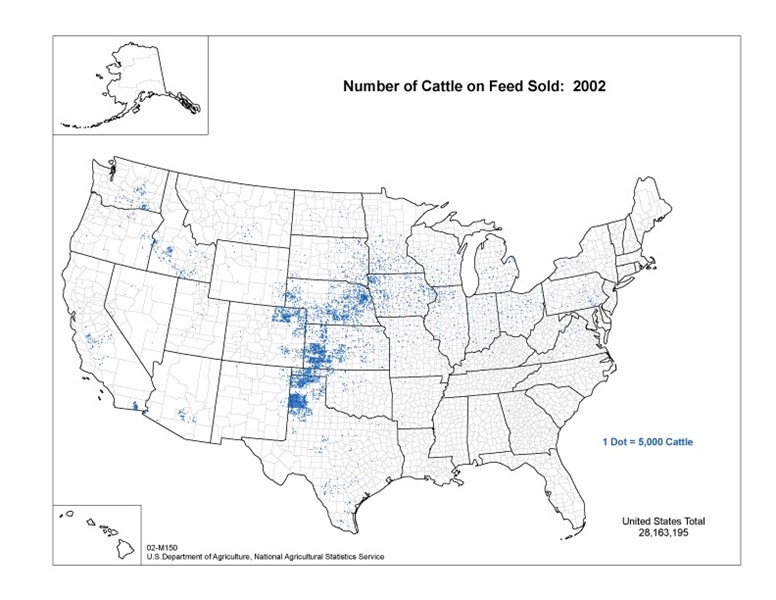How it Works: The U.S. Beef Industry
A look at how beef gets to the consumers plate.
By: Justin Rhinehart, University of Tennessee Beef Cattle Extension Specialist
This article begins a new series that focuses on individual topics related to beef cattle production with explanations about how they work or how they influence the decisions beef cattle producers make. The series will cover a wide scope of topics including specific technologies, industry-related organizations and specific biological systems that cattle rely on for basic function. The most appropriate place to start the series is with a general discussion of how a majority of the beef industry operates in the United States.
Cattle first came to America on Columbus' second voyage in the 15th century. Cattle continued to be imported to the continent but were primarily used for milk and work (most of the meat for people's diets came from wild game). Dr. Larry Corah explains in his publication "Development of a Corn-based Beef Industry" that most of the beef consumed by people on the North American continent for many years came from cattle harvested directly off grass or small calves harvested off the cow. The modern beef industry did not start to shape into its current form—weaning calves so they can be finished with a grain-based diet—until the 1950's when researchers began to report improved weight gain and a more desirable end product from feeding corn to steers.
Until widespread adoption of finishing cattle, pork was the predominant protein source for Americans. With the adoption of feeding corn and the resulting improved product, beef replaced pork as the preferred meat in the U.S. in the early 1950's and was double the per capita consumption of pork by the late 1970's. As the industry rapidly shifted to a predominantly corn-based finishing system, the infrastructure for feeding calves and yearlings (feedlots) and harvesting finished cattle (packers) developed around areas with ample feed and suitable climates for managing cattle (Figure 1).
Figure 1: USDA NASS 2002 Census of Agriculture results for "Number of Cattle on Feed Sold".
Meanwhile, the cow-calf sector flourished in the southeastern U.S. with the demand for feeder claves to stock feedlots in the west and mid-west. There are many areas in the southeast that are unsuitable or marginal for row crop production but that are ideal for grass and forage production to support cow herds and develop replacement heifers. Tennessee producers have taken advantage of that scenario and also added pockets of stocker production to grow calves from weaning to yearling on grass before they are placed in feedlots.
Figure 2 illustrates the flow of cattle through the current U.S. beef production chain. Commercial cow/calf operations produce weaned feeder calves that are sold to feedlots or stocker operators (primarily through local marketing agents; aka "sale barns"). After finishing, those cattle are harvested and processed through packing facilities and the end product is distributed to consumers throughout the U.S. and abroad. It is important to note that information about the quality of that end product and the cattle that produced it flows back through the chain and influences their value at each marketing point. With modern technology, that information can be specifically pointed to regions or individual producers. So, it is important to continue producing cattle that fit the needs of everyone else in the chain.
Figure 2: Cattle and information flow through the U.S. beef production chain.
Purebred or seedstock producers are a vital component of the U.S. beef industry. That sector is responsible for the genetic improvement of traits that are valuable to the production chain (growth characteristics, efficiency, maternal traits for cows and carcass quality). One of the most marked differences in beef production as compared to pork or chicken is the long period of time from when breeding decisions are made by purebred producers until that decision influences the end product. Consider a purebred producer making a breeding decision today and a resulting bull being ready to breed its first set of cows in 18 months to two years. Steers from that bull's first calf crop are not ready for harvest until another two years after that breeding season. Comparing that timeframe to a matter of months for pork or poultry breeding decisions illustrates the long-range planning required of seedstock producers.
Understanding where calves produced in Tennessee end up is essential to making informed breeding and management decisions. Progressive producers understand that and use tools like the checkoff-funded National Beef Quality Audit to stay informed about what consumers look for in a beef product. A good understanding of the U.S. beef industry can enable Tennessee cattle producers to make better decisions, offer a better product in the marketplace, and ultimately realize higher profit from their cattle operation.
As mentioned above, improved information flow from the packer back to the feedlot and back to specific calf-producing regions (in some cases back to the individual farm or ranch) makes the value of feeder calves more quality-based than in the past. Pounds of calf sold is still the major factor in revenue production. But, quality of those pounds influences the value of each of those pounds. Since quality is based on current market and industry information, then underlying value and profit potential are directly related to making use of current industry information.







